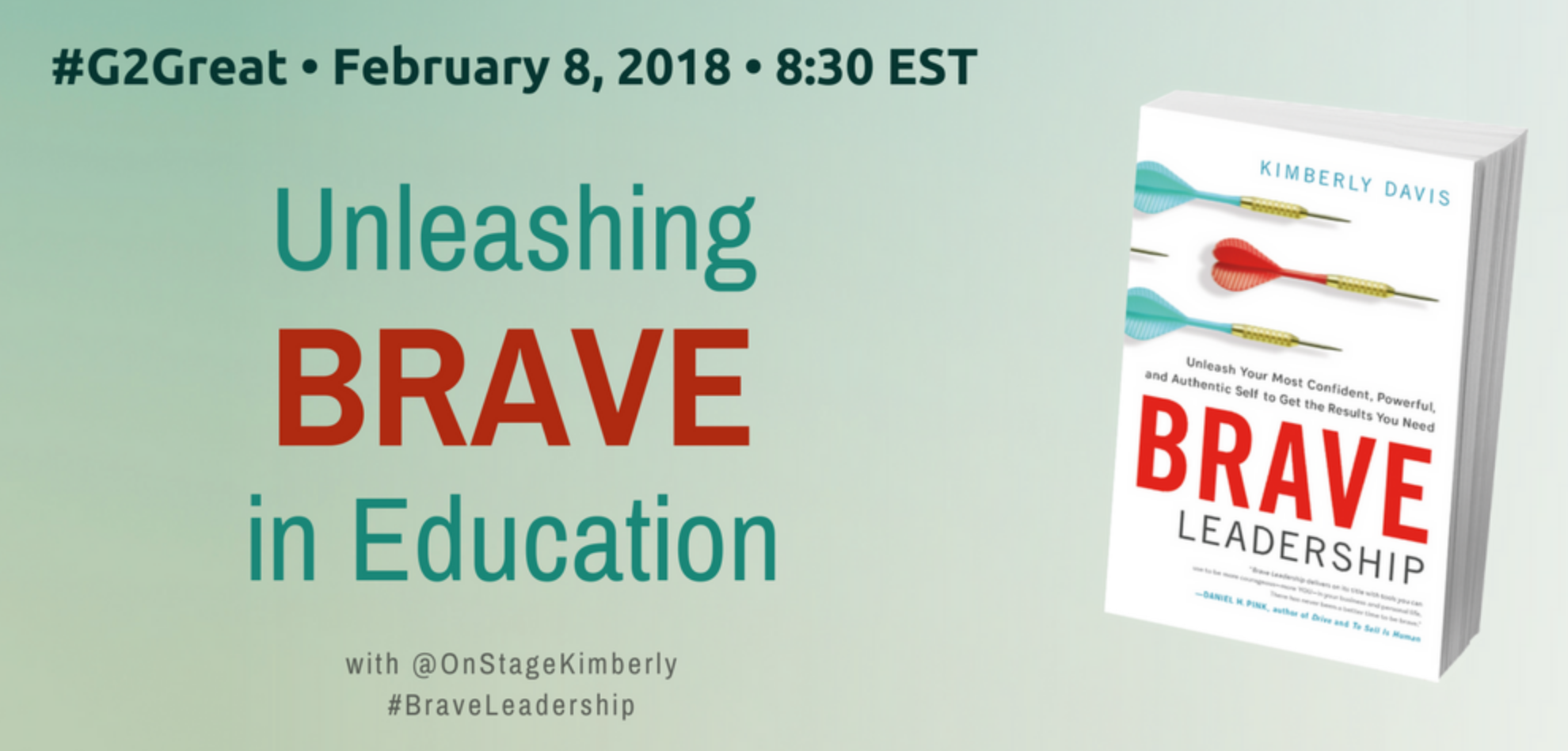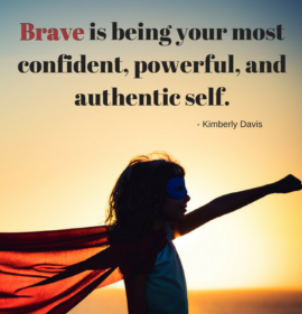by Fran McVeigh
It was fun and exciting to welcome Kimberly Davis, leadership expert and TEDx speaker, back to the #G2Great chat table for the third time to discuss her latest work, Brave Leadership: Unleash Your Most Confident, Powerful,and Authentic Self to Get the Results You Need. Kimberly’s goal was to demystify the whole leadership conversation as she defined brave, discussed barriers to being brave, provided specific strategies to push through to brave and shared tips on how to thrive in a brave new world. The book and the chat both hit the target because this is not just about leadership, it is a lifestyle to embrace. As Kimberly reminds us, “What is possible for you is often way beyond your vision of yourself.”
So What is Brave?
Because we are shaped by our behaviors, actions and responses, we need to celebrate our brave, unleash it, and make sure that we follow through one situation at at time. What do we mean by brave?
The world of work and education has shifted and the old “command-and-control” leadership is not as effective as it may have been in the past. As jobs require more thinking and critical decision-making skills, workers want leaders who model and share those same skills, passions, and commitment. That sense of humanity where the goodness and beauty of all is acknowledged is part of the perception of a vulnerable leader who cares for and connects with the workers around her/him. Brave is a heart thing that adds another dimension to leadership.
“Creativity, engagement, passion, commitment, excitement, loyalty, joy, and trust are all activities of the heart. They come from caring and connection and are accessed through vulnerability.”
So What Exactly is a Leader?
“A leader is someone people want to follow, not have to follow.” (Brave Leadership, p.10)
“Leaders are people, not titles.” (p. 12)
A leader at work could be your supervisor or your principal, but remember the quote just told us that it’s not about the title, so anyone can assume a leadership role. Workers and leaders, when well-matched, are focused. There is no magic formula or prescription for brave leaders. The leader meets the perceived needs of those followers who choose to be there because he or she is genuine, worthy of trust, reliable and believable. The same holds true for schools and learning communities where people follow the leaders at their grade level or in their department and not necessarily those with the fancy titles. It could be “edu-heroes, authors, poets, or mentors!” Wouldn’t the world be an amazing place to live if everyone was a leader? Under this definition, it’s not only possible, it’s also plausible!
Because leadership is about people who want to follow a leader, not those who have to follow, hearts must be connected in trust. In our schools we recognize many times when adults and students have a “leadership identity” – those unique qualities that make a leader special – and embrace them. We want to nurture that confidence, power and authenticity at school, at home and in our community because a “leadership identity” will be valuable to students for the rest of their lives.
Barriers to Brave exist all around us.
Curiosity wanes as children grow older. Our mindsets may become less flexible depending on how well our basic needs are met. If life is about seeing what we want to see; and, in fact, seeking out those who will affirm our beliefs, our perceptions may be a bit skewed. In Brave Leadership, Kimberly suggests that the vulnerability of leaders is impacted by how they interpret the behavior of those around them. Leaders who focus on their impact can harness their attention to be authentic and bring their most authentic self.
How do we do this?
In Brave Leadership the magic happens when we focus on a specific, purposeful action called a “Super Objective”. This allows anyone to align their inner beliefs with their actions in order to create a more authentic pattern of responses to the behaviors and situations around them. Many leadership treatises espouse “goal setting” as a primary function of great leaders, but ambitious, goal-oriented people can burn up. Literally. They become so focused on goals, so goal-driven, and the myriad of goals that they complete and check off that they sometimes forget the purpose of leadership.
“But when we focus solely on goals, our ambition to achieve those goals can easily lead us astray from our best selves and our most fulfilling life. Convinced that we’re doing what we need to do to hit the target, we become numb to the repercussions of our actions, often until it’s too late.”
What makes this book special?
The beauty is in the fact that a “Super Objective” could be for everyone. Not just people with a fancy title. Not just a person in an ivory tower in an office on Wall Street. In our schools, this means that everyone from the principal to the students could have a Super Objective. That focus would be a bit more extensive than a “One Little Word” (#OLW) so everyone can literally make their own impact. (Source for #OLW) The difference is that a brave leader has a focus that extends beyond oneself because that’s how powerful results are achieved.
Two of Kimberly’s many tips for a “Super Objective” that really connected were:
- “Use language that means something to you personally and ignites energy within you. Stay away from jargon. A Super Objective is designed to ignite energy within you, not market you to someone else.
- You should know when you’re doing it and when you’re not.” (p. 129)
Is this going to be easy?
Of course not, because it requires a change in actions and in thinking. We need honest reflection. Reflection that keeps us real and authentic in order to be ourselves, to be heard and to be courageous is going to take intentionality both in private and in public. Reflection makes us vulnerable and that can be so scary! Vulnerability can be a barrier as we’ve been “trained” to not share our most private side. And yet the power that evolves from our vulnerability will move us forward, even if sometimes we take two steps forward and one step back. We are all works in progress but a commitment to brave leadership will put us on our own journey to bring our superpowers to life.
We are leaders whether we are in businesses, schools, communities, or our own homes. All of us have the potential to be leaders. Students. Teachers. Custodians. Lunch workers. Bus drivers. Volunteers. Everyone. Where do we begin?
“We need a strategy! A strategy that gives us a way to look past our perceptions altogether and circumvent our knee-jerk talent for seeing, sorting, deciding, and putting ourselves in a confining box in which we don’t belong. For without the box, the world opens up endless possibilities.”
This is the world that our students have already inherited. What if they studied Brave Leadership in high school government courses or in student council orientations? What if . . .?
Additional Resources:
To review the storify from the chat:
For more information about Brave Leadership:
http://www.braveleadershipbook.com/
To see Kimberly in Action:
Visit her Ted Talk here.
Previously on #G2Great Chats:
5/26/16 Influence in Education Storify
7/16/15 BRAVE Storify
This journey has always been about reaching
your own other shore no matter what it is, and
that dream continues.
—DIANA NYAD

